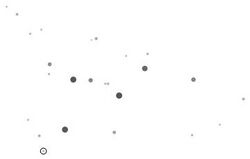Astronomy:Tau Cassiopeiae
| Observation data Equinox J2000.0]] (ICRS) | |
|---|---|
| Constellation | Cassiopeia |
| Right ascension | 00h 55m 00.15523s[1] |
| Declination | +58° 58′ 21.7108″[1] |
| Apparent magnitude (V) | +4.86[2] |
| Characteristics | |
| Spectral type | K1 IIIa[3] |
| U−B color index | +1.05[2] |
| B−V color index | +1.11[2] |
| Variable type | Suspected[4] |
| Astrometry | |
| Radial velocity (Rv) | −20.48±0.31[5] km/s |
| Proper motion (μ) | RA: +60.81±0.19[1] mas/yr Dec.: +56.47±0.17[1] mas/yr |
| Parallax (π) | 18.75 ± 0.20[1] mas |
| Distance | 174 ± 2 ly (53.3 ± 0.6 pc) |
| Absolute magnitude (MV) | 1.269[6] |
| Details | |
| Mass | 1.44[7] M☉ |
| Radius | 10[5] R☉ |
| Luminosity | 40[7] L☉ |
| Surface gravity (log g) | 2.50±0.09[8] cgs |
| Temperature | 4,617±77[7] K |
| Metallicity [Fe/H] | +0.06±0.06[8] dex |
| Rotational velocity (v sin i) | 5.9[5] km/s |
| Age | 3.90[7] Gyr |
| Other designations | |
| Database references | |
| SIMBAD | data |
Tau Cassiopeiae (τ Cassiopeiae) is a solitary,[10] orange hued star in the northern constellation of Cassiopeia. It is bright enough to be seen with the naked eye, having an apparent visual magnitude of +4.86.[2] Based upon an annual parallax shift of 18.75 mas as seen from Earth,[1] this system is located about 174 light years from the Sun.
The spectrum of this star indicates it is an evolved, K-type giant star with a stellar classification of K1 IIIa.[3] It is a suspected variable star of unknown type.[4][11] Tau Cassiopeiae is 3.9[7] billion years old with about 1.44[7] times the mass of the Sun and 10[5] times the Sun's radius. It is radiating 40[7] times the Sun's luminosity from its expanded photosphere at an effective temperature of around 4,617 K.[7]
Naming
In Chinese, 螣蛇 (Téng Shé), meaning Flying Serpent, refers to an asterism consisting of τ Cassiopeiae, α Lacertae, 4 Lacertae, π2 Cygni, π1 Cygni, HD 206267, ε Cephei, β Lacertae, σ Cassiopeiae, ρ Cassiopeiae, AR Cassiopeiae, 9 Lacertae, 3 Andromedae, 7 Andromedae, 8 Andromedae, λ Andromedae, κ Andromedae, ι Andromedae, and ψ Andromedae. Consequently, the Chinese name for τ Cassiopeiae itself is 螣蛇十三 (Téng Shé shísān, English: the Thirteenth Star of Flying Serpent).[12]
References
- ↑ 1.0 1.1 1.2 1.3 1.4 1.5 van Leeuwen, F. (2007), "Validation of the new Hipparcos reduction", Astronomy and Astrophysics 474 (2): 653–664, doi:10.1051/0004-6361:20078357, Bibcode: 2007A&A...474..653V.
- ↑ 2.0 2.1 2.2 2.3 Argue, A. N. (1966), "UBV photometry of 550 F, G and K type stars", Monthly Notices of the Royal Astronomical Society 133 (4): 475, doi:10.1093/mnras/133.4.475, Bibcode: 1966MNRAS.133..475A.
- ↑ 3.0 3.1 Keenan, Philip C.; McNeil, Raymond C. (1989), "The Perkins catalog of revised MK types for the cooler stars", Astrophysical Journal Supplement Series 71: 245, doi:10.1086/191373, Bibcode: 1989ApJS...71..245K.
- ↑ 4.0 4.1 Halbedel, E. M. (February 1993), "tau Cas: a Variable Star after All?", Information Bulletin on Variable Stars (3851): 1, Bibcode: 1993IBVS.3851....1H.
- ↑ 5.0 5.1 5.2 5.3 Massarotti, Alessandro et al. (January 2008), "Rotational and radial velocities for a sample of 761 HIPPARCOS giants and the role of binarity", The Astronomical Journal 135 (1): 209–231, doi:10.1088/0004-6256/135/1/209, Bibcode: 2008AJ....135..209M
- ↑ Soubiran, C. et al. (March 2008), "Vertical distribution of Galactic disk stars. IV. AMR and AVR from clump giants", Astronomy and Astrophysics 480 (1): 91–101, doi:10.1051/0004-6361:20078788, Bibcode: 2008A&A...480...91S.
- ↑ 7.0 7.1 7.2 7.3 7.4 7.5 7.6 7.7 Luck, R. Earle (2015), "Abundances in the Local Region. I. G and K Giants", The Astronomical Journal 150 (3): 88, doi:10.1088/0004-6256/150/3/88, Bibcode: 2015AJ....150...88L
- ↑ 8.0 8.1 Wu, Yue et al. (2010), "Coudé-feed stellar spectral library – atmospheric parameters", Astronomy & Astrophysics 525: A71, doi:10.1051/0004-6361/201015014, Bibcode: 2011A&A...525A..71W.
- ↑ "tau Cas". SIMBAD. Centre de données astronomiques de Strasbourg. http://simbad.u-strasbg.fr/simbad/sim-basic?Ident=tau+Cas.
- ↑ Eggleton, P. P.; Tokovinin, A. A. (September 2008), "A catalogue of multiplicity among bright stellar systems", Monthly Notices of the Royal Astronomical Society 389 (2): 869–879, doi:10.1111/j.1365-2966.2008.13596.x, Bibcode: 2008MNRAS.389..869E.
- ↑ Halbedel, E. M. (November 1989), "Another Opinion on the Variability of tau Cas", Information Bulletin on Variable Stars (3394): 1, Bibcode: 1989IBVS.3394....1H.
- ↑ (in Chinese) AEEA (Activities of Exhibition and Education in Astronomy) 天文教育資訊網 2006 年 7 月 7 日
 |


